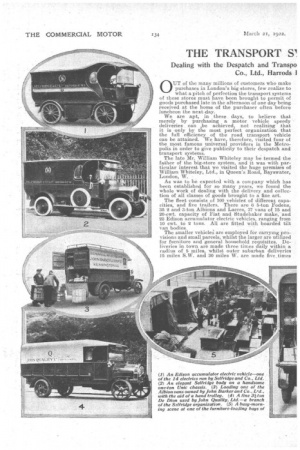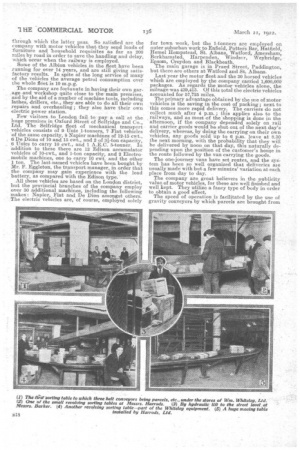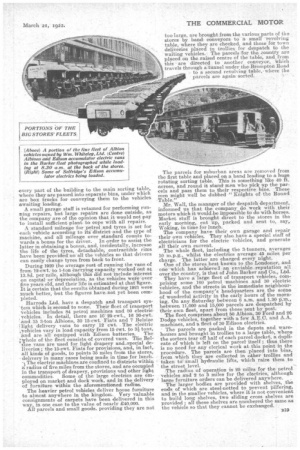purchases in London's big stores, few realize to what a
Page 16

Page 17

Page 18

Page 19

If you've noticed an error in this article please click here to report it so we can fix it.
pitch of perfection the transport systems of these stores must have been brought to permit of goods purchased late in the afternoon of one day being received at the home of the purchaser often before luncheon the next day.
We are apt, in these clays, to believe that merely by purchasing a motor vehicle speedy deliveries. can be achieved, not realizing that it is only by the most perfect organization that the full efficiency of the road transport vehicle can be attained. We have, therefore, visited four of the most famous universal providers in the Metropolis in order to give publicity to their despatch and transport systems. .
The late Mr. William Whiteley may be termed the father of the big-store system, and it was with particular interest that we visited the huge premises of William Whiteley, Ltd., in Queen's Road, Bayswater, London, W. '
AS was to be expected with a company which has been established for so many years, we found the whole work of dealing with the delivery and collection of all classes of goods brought to a fine art.
The fleet consists of 100 vehicles of different capacities, and five trailers. There are 6 5-ton Fodens, 35 2 and 3-ton Albions and Lacres, 37 vans of 15 and 20-cwt. capacity of Fiat and Studebaker make, and 25 Edison accumulator electric vehicles, ranging from 10 cwt. to 2 tons. All are fitted with boarded tilt
van bodies. . . The smaller vehicles are employed for carrying provisions and small parcels, whilst the larger are utilized for furniture and general household requisites. Deliveries in town are made three times daily within a radius of 5 miles, whilst outer suburban deliveries 15 miles S.W. and 30 miles W. are made five times weekly. Each vehicle has a certain area to cover, and most of the work is that of delivery, collecting . being done only in respect of furniture for repair, and the return of selections of goods sent on approbation.
The parcels are conveyed from all parts of the stores to the despatch rooms via travelling band conveyors, a system which was first introduced for big-store work by this company. The parcels run down spiral chutes on to the conveyor bands, of which there are several, and those sent from near or from the extreme ends of the building arrive for despatch with the same facility and rapidity.
In the despatch room are three large revolving tables. for town, suburban, and country deliveries.
The packages arrive by a conveyor, and are sorted and despatched via three separate band conveyors to the aforementioned tables, where they are sorted into bins according to the different delivery areas.
Mr. A. Wren, the despatch manager, mentioned some of the particular advantages of motor vehicles, The company are able to give daily delivery direct to the doom of customers who may be miles from a railway station. Provisions are brought from the mar kets by the company's own vehicles in the early hours of the morning, and are delivered to the customers within a few hours, and in perfect condition. As re gards furniture and other large goods, a considerable amount is saved in packing, and furniture can be placed in position in a house many miles away just as
easily as if it had to be delivered to a place in a neighbouring road. The use of road transport vehicles also does away with the cost of returning empties. The company attach great importance to the publicity value of their fleet. Whiteley is almost a household word, and this is in a great part due to the name being displayed on the vehicles in the various districts
through which the latter pass. So satisfied are the company with motor vehicles that they send loadsof :furniture and household requisites as ar as 200 miles by road in order to save the handling and delay, which occur when the railway is employed. Some of the Albion vehicles in the fleet have been running for over 14 years, and are still giving satisfactory results. In spite of the long service of many of the vehicles the average petrol consumption over the whole fleet is 10 m.p.g. • The company are fortunate in having their own garage and workshop quite close to the main premises, and by the aid of a numher of machine tools including lathes, drillers, etc., they are able to do all their own repairs and overhauling ; they also have their own electric power station.
Few visitors to London fail to pay a call at the huge premises in Oxford Street of Selfridge and Co., Ltd. The Selfridge fleet of mechanical transport vehicles consists at 9Unic 1-tanners, 7 Fiat vehicles "of the same capacity, 8 Napier machines of 12-15 cwt., 6 De Dions of 10 and 15 cwt. and 2 of 31-ton capacity, 6 Unica to carry 10 cwt., and 1 A.E.C. 5-tonner. In addition to these there are 12 Edison accumulator vehicles of 10-cwt., and 1-ton capacity, and 2 Electro, mobile machines, one to carry 10 cwt, and the other 1 ton. The last-named vehicles have been bought by Mr. F. Egglethn, the transport manager, in order that the company may gain experience with the lead battery, as compared with the Edison type..
All these vehicles are based on the London district, but the provincial branches of the company employ over 50 additional machines_, including the following makes : Napier, Fiat and. De Dion amongst others. The electric vehicles are, of course, employed solely for town work, but the 1-tanners are employed on outer suburban work to Enfield, Potteis Bar, Hatfield, Hemel Hempstead, St. Albans, Watford, Amersham, Berkbamsted, Harpenden, Windsor, Weybridge, Epsom, Croydon and Blackheath. The main garage is in Praed Street, Paddington, but there are others at Watford and St. Albans.
Last year the motor fleet and the 30 horsed vehicles which are employed by the company carried 1,600,000 packages. As regards the motor vehicles alone, the mileage was 439,415. Of this total the electric vehicles accounted for 57,725 miles.
The primary advantage obtained by the use of motor vehicles is the saving in the cost of packing; next. to this comes more rapid delivery. The carriers do not collect mirth after 4 p.m. ; this applies also to the railways, and as most of the .shopping is done in the afternoon, if the company depended solely on rail and carrier goods would be shut out of the next day's delivery, whereas, by doing the carrying on their own vehicles, any goods sold up to 6 p.m. leave at 8.30 the next morning, with the probability that they will be delivered by noon on that day, this naturally depending upon the position of the customer's house in the route followed by the van carrying the goods.
The one-journey vans have set routes, and the syStern has been so well organized that deliveries are usually made with but a few minutes' variation at each place from day to day.
The company are great believers in the publicity value of motor vehicles, for these are well finished and well kept. They utilize a fancy type of body in order to obtain a good effect.
The speed of operation is facilitated by the use of gravity conveyors by which parcels are brought from every part of the building to the main sorting table, where they are passed into separate bins, under which are box trucks for conveying them to the vehicles awaiting loading.
A small garage staff is retained for performing rimning repairs, but large repairs are done outside, as the company are of the opinion that it would not pay to install sufficient plant to cope with all repairs.
A standard mileage for petrol and tyres is set for each vehicle according to itadistrict and the type of machine, and all mileage over standard counts towards a bonus for the driver. In order to assist the latter in obtaining a bonus' and, incidentally, increase the life of the tyres, detachable, contractible rims have been provided on all the vehicles so that drivers can easily change tyres from back to front.
During 1920 the average cost of running the vans of from 12-cwt.to 1-ton carrying capacity worked out at 13.8d. per mile, although this did not include interest on capital or depreciation, as the vehicles were over five years old, and their life is estimated at that figure. It is certain that the results obtained during 1921 were much better, but the figures have not yet been completed.
Harrods Ltd. have a despatch and transpo-rt sy-s'kern which is second to none. Their fleet of transport vehicle.s includes 84 petrol machines and. 80 electric vehicles. In detail, there are 16' 25-cwt., 16 30-cwt. and _15 3-ton Albions, 30 15-cwt. Fiats and 7 Belsize Tight delivery vans to carry 12 cwt. The electric ,vehicles vary in load capacity from 15 cwt. to 3i tons, 4nel are all equipped with Edison batteries. The Ivhole of the fleet consists of covered vans. The Belsize vans are used for light drapery and-special deliveries • the 15-ewt. Fiats for provisions, and, in fact, all kind; of goods, to points 35 miles from the stores, delivery in many cases being made in time for lunch. "4. The electric machines are confined to districts within
radius of five miles from the stores, and are occupied in the transport of drapery. provisions end other light commodities. Some of the large electrics are employed on market and dock work, and in the delivery of furniture within the aforementioned radius.
The heavier petrol vehicles deliver house furniture to almost anywhere in the kingdom. Very valuable consignments of carpets have been delivered in this way, in one case to the value of nearly 240,000. All parcels and small goads. providing they are not too large, are brought from the various parts of the stores by band conveyors to 'a small revolving table, where they are checked, and thosefor town deliveries placed in trollies: for despatch to the waiting vehicles. The parcels for the country are placed an the raised centre of the table, and, from this are directed te another conveyor, which travels through a tunnel under theBrampton Road to a second revolving table,. where the parcels are again sorted.
The parcels for suburban areas are removed from the first table and placed on a band leading to a huge rotating sorting table. This is something like 40 ft. across, and round it stand men who pick up the parcels and pass them to their respective bins. These men might well be dubbed "Knights of the Round Table.
Mr. Wall, the manager of the despatch department, informed us that the company do work with their motors which it would be impossible to do with horses. Market stuff is brought direct to the stores in the early moreing, cut up, packed and sent to, say, Woking, in time for lunch. The company have their own garage and repair their own vehicles. They also have a special staff of electricians for the electric vehicles, and generate all their own current.
The whole fleet, including the 3-tanners, averages 10 m.p.g. whilst the electrics average '45 miles per charge. he latter are charged every night. One of the stores best. known to the Londoner, and one which has achievel -an enviable .reputation all over the country, is that of John Barker and Co., Ltd.
They have a large fleet of transport vehicles, com
prising some 160 petrol machines and 30 electric vehicles, and the streets in the immediate neighbourhood of the company's headquarters are the scene of wonderful activity in the early hours of the morning. On any Saturday between 6 a.m. and 1.30 p.m., between 11,000 and 15,000 parcels are despatched by their own fleet, apart from those 'sent by post. The fleet comprises about 50 Albion, 30 Ford and 26 Dodge vehicles, together with a few A.E.O. and A.A. machines, and a fleet of 30 Edison electrics.
• The parcels are packed in the depots and ware
houses and brought in trollies to a large table, where the sorters tear off half of each parcel docket, a duplicate of which is left on the parcel itself ; thus there is no need for any clerical work at this point in the procedure. The parcels are then placed into bins, from which they are collected in other trollies and taken to small hydraulic lifts, which raise them to the street level.
The radius of operation is 25 Miles for the petrol vehicles and 2 to 3 miles for the electrics, although large furniture orders can be delivered anywhere.
The larger bodies are provided with shelves, the
ends of which are steel-netted to prevent Pilfering, and in the smaller vehicles, where it is not convenient to build long shelves' two sliding cross shelves are provided ; all these shelves are numbered the same as the vehicle so that they cannot be exchanged.


































